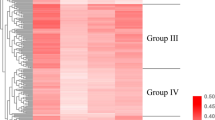Abstract
To achieve germplasm innovation and study genetic variation of important traits of bamboo plants, we used Bambusa multiplex, B. chungii, and Dendrocalamus latiflorus as parent materials for distant and inbred hybridizations. Two hybrid populations and three inbred populations were obtained: two populations consisted of 57 hybrid progenies from B. multiplex × B. chungii, 26 hybrid progenies from B. multiplex × D. latiflorus, and three inbred progenies were from B. multiplex, B. chungii, and D. latiflorus. Traits for growth, morphology, and fiber were examined from the five populations when plants were 3 years old. Two hybrid populations had significant growth advantages in terms of height, diameter at ground level and internodal length. In terms of variability in morphological traits, the two hybrid populations followed the same trend, namely, seven morphological traits showed phenotypes that were intermediate to those of their parents; three morphological traits showed strong maternal effects, and three other morphological traits showed strong paternal effects. Among the five populations, the two hybrid populations had high arithmetic average fiber length, length-weighted average fiber length and mass-weighted average fiber length, moreover, extensive variations of these three traits were observed within these two hybrid populations. The establishment of distant hybrid populations from these three bamboo species increased the genetic diversity more than in the other species examined. This work provides excellent materials for breeding new varieties and lays the foundation for understanding the genetics of important traits by analyzing related functional genes.

Similar content being viewed by others
References
Chambers SM, Heuch JHR, Pirrie A (1991) Micropropagation and in vitro flowering of the bamboo Dendrocalamus hamiltonii Munro. Plant Cell Tissue Organ Cult 27:45–48
Geng YH, Peng X, Liu CS (2008) Research advances of B. pervariabilis × D. Daii in cultivation and utilization. J Chongqing For Sci Technol 3:5–10
Kleinhenz V, Midmore DJ (2001) Aspects of bamboo agronomy. Adv Agron 74:99–153
Lin CS, Lin CC, Chang WC (2004) Effect of thidiazuron on vegetative tissue-derived somatic embryogenesis and flowering of bamboo Bambusa edulis. Plant Cell Tissue Organ Cult 76(1):75–82
Lin XC, Lou YF, Liu J, Peng JS, Liao GL, Fang W (2010) Crossbreeding of Phyllostachys species (Poaceae) and identification of their hybrids using ISSR markers. Genet Mol Res 9(3):1398–1404
McClure FA (1966) The bamboos—a fresh perspective. Harward University Press, Cambridge, pp 82–143
Ning CQ, Dai QH (1995) Hybridiztion between Bambusa pervariabilis × Dendrocalamopsis daii and progeny selection. Guangxi For Sci 24(4):167–168
Yang Q (2007) Research status of B. pervariabilis × D. Daii and cost-benefit analysis. Shandong For Sci Technol 3:101–103
Yeh ML, Chang WC (1986) Somatic embryogenesis and subsequent plant regeneration from inflorescence callus of Bambusa beecheyana Munro var. beecheyana. Plant Cell Rep 5:409–411
Yuan JL, Gu XP, Yue JJ, Ma NX, Chen YT (2011) Flowering biology and crossing of Bambusa multiplex. Sci Silvae Sin 47(8):61–66
Zeng HC, Xu ZQ (2000) Extend test of Bambusa pervariabilis × (Dendrocalamus latiflorus + B. textilis) No. 1 in Dongguan City. Guangdong For Sci Technol 16(1):25–29
Zhang GC, Chen FS (1986) Study on bamboo hybridization. Guangdong For Sci Technol 3:1–5
Zhang GC, Chen FS (2006) Study on the bamboo hybridization Bambusa pervariabilis × Dendrocalamus latiflorus No. 7. Agric Internet Inf 4:149–151
Author information
Authors and Affiliations
Corresponding author
Additional information
Project funding: This study was funded by Natural Science Foundation of China (31500551); the Fundamental Research Funds for the Central Non-profit Research Institute of Chinese Academy of Forestry (CAFYBB2016QB008); Zhejiang Science and Technology Major Program on Agricultural New Variety Breeding (2016C02056-8); the Fundamental Research Funds for the Central Non-profit Research Institute of Research Institute of Subtropical Forestry-Chinese Academy of Forestry (RISF2014001). The funders had no role in study design, data collection and analysis, decision to publish, or preparation of the manuscript.
The online version is available at http://www.springerlink.com
Corresponding editor: Hu Yanbo.
Rights and permissions
About this article
Cite this article
Yuan, JL., Yue, JJ., Zhong, YB. et al. Genetic variation in distant and inbred hybridization progenies from three sympodial bamboo parent species. J. For. Res. 30, 1323–1329 (2019). https://doi.org/10.1007/s11676-018-0817-0
Received:
Accepted:
Published:
Issue Date:
DOI: https://doi.org/10.1007/s11676-018-0817-0




